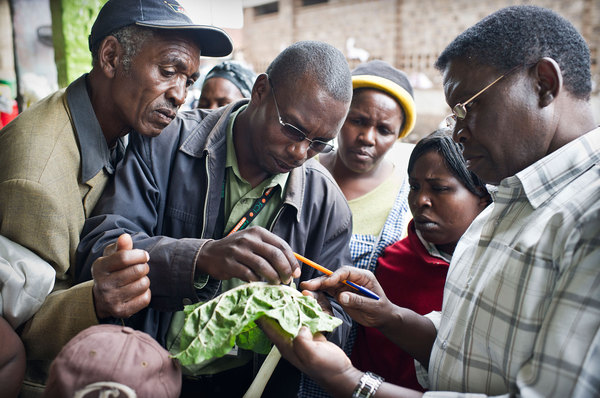Factsheet of the month: January 2015 – Management of clubroot disease in crucifers
Clubroot is a serious disease of crucifers. It is found in many countries across the world (see the Plantwise distribution map). It is caused by the fungus Plasmodiophora brassicae, whose spores can live for many years in the soil. This makes the disease difficult to control once a field has been infected. To find out more about…
Black Rot Disease Hits Uganda
Vegetable farmers in the Kayunga and Mukono districts of Uganda are reporting crop losses due to black rot disease. One farmer, Twaha Kahooza of Kyampisi village, Kayunga Sub-county, says he had planted four acres of cabbages and was expecting about Shs18m (about £4,500 or US$7,000) from the harvest, however he only managed to get Shs5m…
Maize Lethal Necrosis Disease Spreads To Uganda
Maize Lethal Necrosis disease, which was first reported in Kenya and Tanzania, has now spread to Uganda, raising concerns for food security in the country. The Ministry of Agriculture has warned that Maize Lethal Necrosis has been reported in districts in eastern Uganda, including Busia and Tororo. A spokesman for the Agriculture Research Organisation, Robert…
New Type of Invasive Whitefly Recorded In South Africa
A species of whitefly that transmits cassava mosaic virus has been detected in South Africa for the first time. The whitefly, Bemisia tabaci is a cryptic species complex containing some important agricultural pests and virus vectors. The term ‘cryptic species complex’ means that Bemisia tabaci is considered to be a complex of at least 24 different…
The Climate Reality Project- Coffee Production Hit by Climate Change
[ustream id=27051308 hwaccel=1 version=3 width=480 height=302] Video streaming by Ustream Recently aired as part of The Climate Reality Project (founded by Al Gore), this documentary contains a 5 minute film about climate change and smallholder coffee production in Colombia. The film featured as part of a 24 hour online stream of climate documentaries and discussions…
The Soybean Gene: Scientists Discover the Key to Nematode Resistant Soybeans
Soybean (Glycine max) is an important crop that provides a sustainable source of protein and oil worldwide in countries such as the USA, Brazil, Argentina, India and many African countries, including Nigeria, South Africa and Uganda. The soybean cyst nematode Heterodera glycines is a microscopic roundworm that feeds on the roots of soybean and is…
Plant doctor in Tanzania uses the Plantwise Knowledge Bank to diagnose crop diseases
Mr Kimomwe H. Kimomwe, a plant doctor at the Lukozi plant clinic in Lushoto district, Tanzania explains in this video how he used the Plantwise Knowledge Bank to find out what problem a farmer had on his crop of cabbages. He showed the farmer the results from the diagnostic tool, and the farmer was able…
Update from Kenyan plant doctors
MaryLucy from the Plantwise Knowledge Bank team, who is based in Kenya, has been visiting plant doctors in the Rift Valley to train them in data management. She has already had some very enthusiastic responses from plant doctors and agricultural officers who welcome the use of plant clinics in conjunction with the Knowledge Bank to…
Kenyan plant doctors respond to new data management
This week MaryLucy, a member of the Knowledge Bank team based in Nairobi, has been travelling across Kenya to meet some of our plant doctors and offer them data management training to help improve the support available to farmers. This training involves highlighting the importance of accurate data collection from farmers who attend Plantwise plant…
Maize disease in Kenya no longer a mystery and being controlled
Update [March 2013]: More information about the pests and viruses associated with Maize Lethal Necrosis disease can be found on the Plantwise Knowledge Bank. In January this year, ProMed-mail reported an undiagnosed disease of maize that had been destroying farmers’ crops in the Rift Valley of Kenya since the previous September. The Ministry of Agriculture…
- « Previous
- 1
- 2

